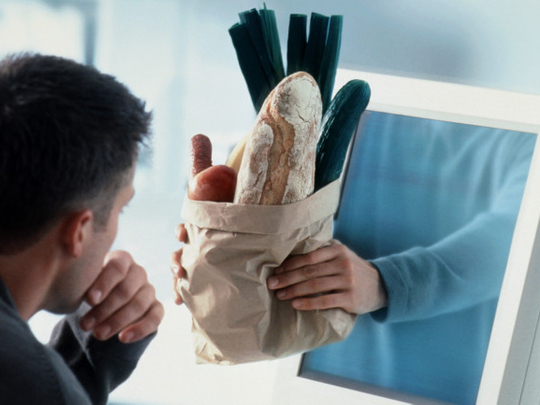
You can put online a fancy shopping website with detailed product info, image galleries, videos, testimonials, but the one thing you will not be able to overcome is the fact that your site is trapped behind a display. Shoppers can imagine and visualise what you are pitching at them, but they cannot touch, feel, smell or actually hold your products. It is what we call the great display divide — where the product and the buyer remain on either side of the screen.
However, both the online and offline shopping worlds are learning from each other, and from technology — trying out new tricks that will keep your buying and spending spree going. Here we look at a few ideas that promise to bridge the gulf between the virtual and the real store and enhance your shopping experience.
Touch and go
At the start of July, Microsoft demoed a new-fangled piece of technology called Actuated 3D Display with Haptic Feedback. In simple terms, you could call it the push-back display. It intelligently reacts when you poke at it. So if you touch a 3D block of concrete on display, the tactile response is completely different from what you would sense on touching a block of wood or sponge.
Michel Pahud, Senior Researcher at Microsoft Research, says: “What we have done is to take the strength of the 2D display with multitouch, and then we added a third dimension with force feedback.”
Force and haptic feedback has been around for years, especially in gaming accessories such as joysticks, mice and play wheels — every racing fan knows that when your virtual car bangs into another car, the game wheel rumbles and grumbles. These technologies have been put to other uses too, including shopping. But as IBM notes in its IBM 5 in 5 2012 report, those are “closed environments where the touch doesn’t actually connect to where we are in reality”. Instead, future devices will bring together “virtual and real world experiences to not just shop, but feel the surface of produce and get feedback on data such as freshness or quality.”
Mobiles have feelings
The IBM paper goes on to predict that within five years, your mobile device will let you touch what you’re shopping for online.
“It will distinguish fabrics, textures and weaves so that you can feel a sweater, jacket, or upholstery — right through the screen. Imagine shopping for a wedding dress on a phone or tablet, and being able to feel the satin gown, or even the intricate beading and buttons, or the lace on the veil.”
Capture sensations
To make this work ultra realistically, all you need is a touchy feely database that has captured the sensations for various products — a dictionary of textures. A shopping site can access this data, map it to what the user is checking out and send the right sensations to the phone or computer display. The IBM report concludes, “By matching variable frequency patterns of vibration to physical objects, so that when a shopper touches what the webpage says is a silk shirt, the screen will emit vibrations that match what our skin mentally translates to the feel of silk.”
The smell of things
Similarly a lexicon of odours would, at least in theory, make smell-o-vision a reality. A small dispenser attached to your phone or computer would emit the right mix. Skimming through the Wikipedia page on digital scent technology, you come across a road littered with companies that set out on the scent of success.
Around 2001, DigiScents showed off a small attachment called the iSmell, which had a cartridge with 128 ‘primary odours’, which could be mixed and matched. According to Wikipedia, “the company had indexed thousands of common odours, which could be coded, digitised, and embedded into web pages or email.” That story folded as funding dried.
There have been other attempts, like TriSenx’s Scent Dome, which was about the size of a teapot and could generate up to 60 different smells; the Kaori Web with six smelly cartridges; a miniaturised digital scent solution, announced in 2011, that can release scents from 10,000 odours as also a Japanese smelling screen, unveiled in March 2013, that combines a digital display with four small fans that direct an emitted order to a specific spot on the screen. Well, the battle for your noses will continue, and we believe it will be won soon.
Shopping in 3D
Virtual aisles that you could walk down, pick stuff off and put in your shopping cart, have been around in varying degrees of complexity. But a lack of computing power, bandwidth and coding chops has made these shopping options more of a gimmick. That obviously will change as technologies all around improve. Combine it with accessories such as the Kinect, like Keyfree’s Store Trek has done and in the near future, you will actually be able to walk inside a virtual store, roam around, meet friends, get advice from other shoppers, all from the comfort of your home. And as shown by Tesco’s Endless Aisle, you may not even reach the end of the aisle, as you would in a real store.
Shopping for 3D
eBay recently launched a service in the US called eBay Exact, allowing consumers to shop for objects made using 3D printers.
The online site teamed up with 3D printing companies Sculpteo, Makerbot and HotPot Factory to offer anything from iPhone cases to jewellery. There are also services such as Shapeways that let you upload your ideas and requirements, which are then 3D-printed and shipped off to you.
And as 3D printer costs plummet, we see this nascent market booming. People will buy and sell home-made 3D objects, even blueprints — which you download and run by your own 3D printer. Voila, you manufactured the product right at home.
Watch and tap
If startups like Stipples and Cinematique have their way, shopping will be baked right into images and videos you consume, even on sites that have nothing to do with e-commerce. Imagine you are watching a movie or going through a photogallery on your iPad. You like the shirt your favourite actor is wearing. You wonder if that style is also available in red. Well, no need to jump out of your current flow to find out — simply touch the object and access details, comparisons, options. Yes, even buy.
Retail, but online
What if you could buy items online, but at a physical store? Sounds confusing? Well, these strange mashups of digital and physical are called ‘virtual supermarkets’.
Your shopping is still online, but it is done on screens at actual stores. In fact, the only items on display at such stores are the screens, and not any products. The idea, apparently, is to give you the best of both worlds — the convenience of online and the adventure offline.













